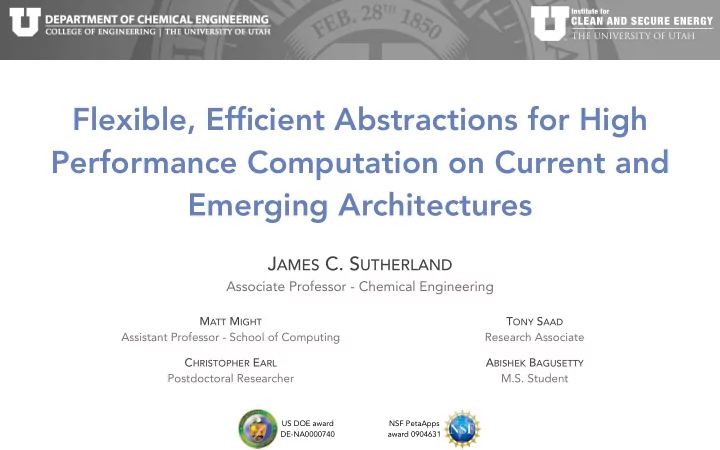

Institute for CLEAN AND SECURE ENERGY THE UNIVERSITY OF UTAH TM Flexible, Efficient Abstractions for High Performance Computation on Current and Emerging Architectures J AMES C. S UTHERLAND Associate Professor - Chemical Engineering M ATT M IGHT T ONY S AAD Assistant Professor - School of Computing Research Associate C HRISTOPHER E ARL A BISHEK B AGUSETTY Postdoctoral Researcher M.S. Student US DOE award NSF PetaApps DE-NA0000740 award 0904631
CLEAN AND SECURE ENERGY Motivation THE UNIVERSITY OF UTAH CLEAN AND SECURE ENERGY THE UNIVERSITY OF UTAH Institute for Complex physics ⇒ complex software! TM • is this necessary, or just a result of looking at the problem in the wrong way? Institute for Changing from model “A” to model “B” ... TM • may require different transport equations • may introduce different nonlinear coupling Spatial discretization frequently permeates software design • Model developers typically must deal with “mesh loops” • often resort to “copy/paste/modify” tactics that are highly bug-prone • Future proofing: • What if you want to do OpenMP on these loops? • What happens when you learn that OpenMP is not the right tool? • pthreads, CUDA / OpenCL ... ? Questions: Can we write efficient software that... • ... naturally handles complexity and allows us to easily extend/replace existing models? • ... allows programmers to easily and robustly express intent while not worrying about “details?” • ... allows us to refactor for different hardware architectures without rewriting the code base?
CLEAN AND SECURE ENERGY Flexible… THE UNIVERSITY OF UTAH CLEAN AND SECURE ENERGY THE UNIVERSITY OF UTAH Register all expressions Institute for Γ = Γ ( T, p, y i ) • Each “expression” calculates one or more field quantities. TM • Each expression advertises its direct dependencies. Institute for Set a “root” expression; construct a graph TM Direct (expressed) • All dependencies are discovered/resolved automatically. dependencies. • Highly localized influence of changes in models. • Not all expressions in the registry may be relevant/used. Indirect (discovered) From the graph: dependencies. • Deduce storage requirements & allocate memory (externally to each expression). • Automatically schedule evaluation, ensuring proper ordering. • Asynchronous execution is critical! (overlap communication & u Γ Expression computation) τ Registry p • Robust scheduling algorithms are key. y i T s φ ρ φ *Notz, Pawlowski, & Sutherland (2012). ACM Transactions on Mathematical Software, 39(1).
Recommend
More recommend